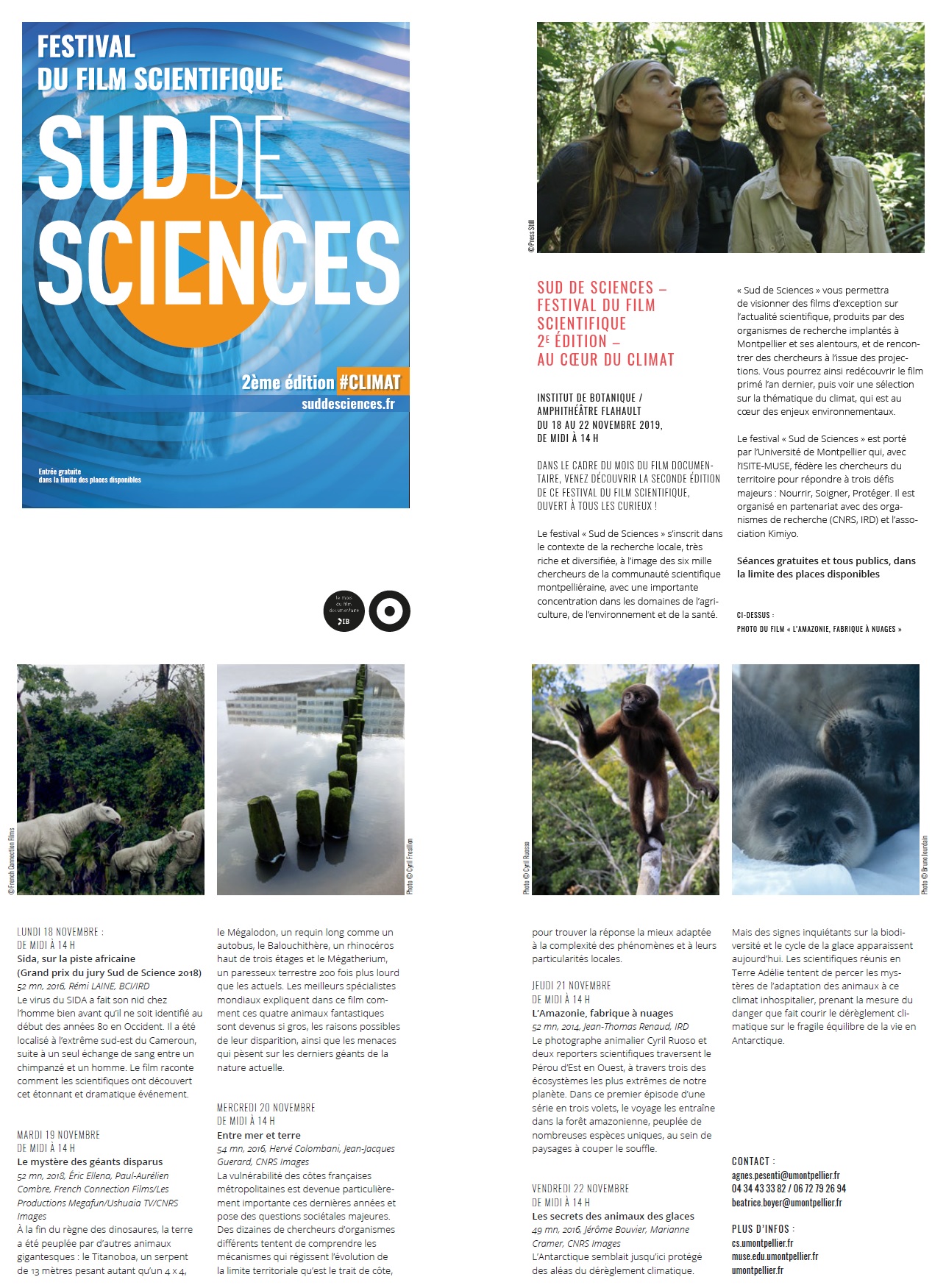November 18 to 22, 2019: Sud de Sciences science film festival (At the heart of the debate)
November 18 to 22, 2019 from 12pm to 2pm -
Amphithéâtre Charles Flahault, Institut de Botanique
Free admission, subject to availability
As part of Documentary Film Month, come and discover the second edition of this scientific film festival open to all the curious.
The "Sud de Sciences" festival is part of a very rich and diverse local research scene, reflecting the six thousand researchers in Montpellier's scientific community, with a strong concentration in the fields of agri-culture, the environment and health.
"Sud de Sciences" will enable you to view exceptional films on current scientific issues, produced by research organizations based in and around Montpellier, and to meet researchers after the screenings. You'll be able to rediscover last year's award-winning film, followed by a selection on the theme of climate, which is at the heart of environmental issues.
The "Sud de Sciences" festival is supported by the University of Montpellier, which, together with ISITE-MUSE, federates the region's researchers to meet three major challenges: Feed Care, Protect. It is organized in partnership with research organizations (CNRS, IRD, Inserm) and the Kimiyo association.
Program
MONDAY, NOVEMBER 18, 12 NOON TO 2 P.M.
Sida, sur la piste africaine (Grand prix du jury Sud de Science 2018)
52 min, 2016, Rémi Lainé, BCI Beau comme une image, IRD, with the participation of France Télévisions.
The AIDS virus made its home in humans long before it was identified in the West in the early 80s. It was located in the far south-east of Cameroon, following a single exchange of blood between a chimpanzee and a human. The film tells the story of how scientists discovered this astonishing and dramatic event.
TUESDAY NOVEMBER 19 FROM 12 PM TO 2 PM
Screening at 9:30 am for "Collège" and "Lycée" groups
The mystery of the vanished giants
52 mn, 2018, Éric Ellena, Paul-Aurélien Combre, French Connection Films/Les Productions Megafun/Ushuaia TV/CNRS Images.
At the end of the dinosaurs' reign, the earth was populated by other gigantic animals: the Titanoboa, a 13-meter snake weighing as much as a 4 x 4; the Megalodon, a shark as long as a bus; the Balouchithère, a three-story-high rhinoceros; and the Megatherium, a ground sloth 200 times heavier than today's sloths. In this film, the world's leading specialists explain how these four fantastic animals got so big, the possible reasons for their disappearance, and the threats facing the last giants of nature today.
WEDNESDAY, NOVEMBER 20, 12 - 2 PM
Screening at 9:30 a.m. for "Lycée" groups
Between sea and land
54 mn, 2016, Hervé Colombani, Jean-Jacques Guerard, CNRS Images, CNRS-INSU, BRGM.
The vulnerability of the French coastline has become particularly acute in recent years, raising major societal issues. Dozens of researchers from different organizations are trying to understand the mechanisms that govern the evolution of the territorial boundary that is the coastline, in order to find the most appropriate response to the complexity of the phenomena and their local particularities.
THURSDAY, NOVEMBER 21TH FROM 12 TO 2 PM
Screening at 9:30 a.m. for "Collège" and "Lycée" groups
The Amazon, cloud factory
52 min, 2014, Jean-Thomas Renaud, French Connection Films, Codex Now, Vosges Television, IRD, USHUAÏA TV, TV5 Monde, SBS TV Australia, TV Peru.
Wildlife photographer Cyril Ruoso and two scientific reporters cross Peru from East to West, through three of our planet's most extreme ecosystems. In this first episode of a three-part series, their journey takes them to the Amazon rainforest, home to a host of unique species and breathtaking landscapes.
FRIDAY, NOVEMBER 22 FROM 12 PM TO 2 PM
Screening at 9:30 a.m. for "Lycée" groups
The secrets of ice animals
49 mn, 2016, Jérôme Bouvier, Marianne Cramer,Paprika Films, Wild-Touch Production, Andromède Océanologie, Arte France, CNRS Images.
Until now, Antarctica seemed protected from the vagaries of climate change. Now, however, worrying signs are emerging about biodiversity and the ice cycle. Scientists gathered in Terre Adélie are attempting to unravel the mysteries of how animals adapt to this inhospitable climate, and to assess the danger posed by climate change to the fragile balance of life in Antarctica.
